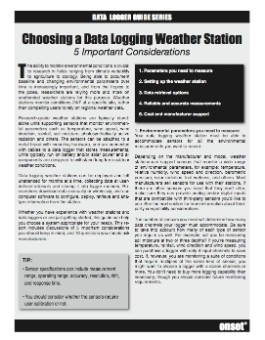 |
White Paper - choosing a weather station, Onset Computer Corporation (4 pages, about 2150 words) This
is one of a series of white papers I worked on geared toward educating potential customers about choosing and using data logging devices for a wide variety of field and industry applications. Each piece served as an introduction to using data loggers for a particular audience, and answered many of the questions asked of sales staff. EXCERPT: Choosing a Data Logging Weather Station: 5 Important Considerations The ability to monitor environmental conditions is crucial to research in fields ranging from climate variability to agriculture to zoology. Being able to document baseline and changing environmental parameters over time is important, and from the tropics to the poles, researchers are relying more and more on unattended weather stations for this purpose. Weather stations monitor conditions 24/7 at a specific site, rather than compelling users to rely on regional weather data. Research-grade weather stations are typically stand-alone units supporting sensors that monitor environmental parameters such as temperature, wind speed, wind direction, rainfall, soil moisture, photosynthetically active radiation and others. The sensors can be attached to a metal tripod with mounting hardware, and are connected with cables to a data logger that stores measurements. Units typically run on battery and/or solar power and all components are designed to withstand long-term outdoor weather conditions. Data logging weather stations can be deployed and left unattended for months at a time, collecting data at user-defined intervals and storing it into logger memory. Researchers download data manually or wirelessly, and use computer software to configure, deploy, retrieve and analyze information from the station. [break...] 4. Reliable and accurate measurements Data means nothing if it's inaccurate, incomplete, or doesn't make it back to the office. Choose a weather station with reliable sensors, durable hardware, and enough power to keep going even if you have to postpone a data download. There are several things to consider to ensure reliable measurements. First, look at the operating range and accuracy of the sensors. Carefully examine these specifications to make sure the sensors can measure desired parameters with the accuracy necessary for your research, and within the environmental conditions likely for your field site. When looking at accuracy specifications make sure they include all sources of measurement error (such as the A/D and reference voltage errors), and are not just for the sensor. Your weather station's sensors and hardware will have to withstand the particular environmental conditions of your field site. Can the system hold up under driving rain, wide temperature fluctuations, and curious animals? What is its wind speed rating? Can the sensors be mounted with good spacing and minimal shading so that each has enough surrounding free space for accurate measurements? [continues...]
|